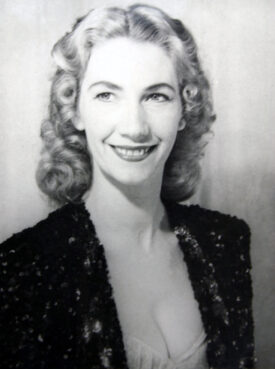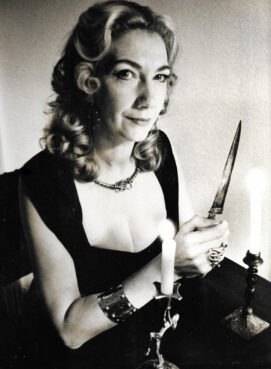(RNS) — Patricia Crowther, a Wiccan high priestess often described as the United Kingdom’s oldest witch, died in her home in Sheffield, England, on Sept. 24, at the age of 97. But Crowther was known for more than simply her longevity: She was instrumental in growth of the modern witchcraft movement in her own country and abroad.
Ashley Mortimer, a close friend for more than 20 years and Wiccan high priest, said Crowther was one of the last remaining direct initiates of Gerald Gardner, who founded Wicca in the mid-20th century. Mixing various occult teachings with “European pre-Christian religious practices and beliefs,” explained Mortimer, Gardner launched a modern pagan religion that combines magic, also known as witchcraft, with the cycle of nature as the core of its belief system.
Crowther was “right at the forefront,” creating her own Wiccan coven in Sheffield in the 1960s, when there were “fewer than half a dozen” Gardnerian covens, Mortimer said. She was also “brave enough,” he said, to be public at the very beginning of the witchcraft movement when others could not. She did media interviews and wrote popular books and articles.
“She was never undercover,” Mortimer said, and therefore became a powerful voice in the growing religious movement and a staunch defender.

Patricia Dawson, in a pre-1961 photo. (Photo courtesy of Ian Lilleyman)
Born Oct. 14, 1927, to Clare and Alfred Dawson in Sheffield, she dedicated her early life to the performing arts. “She loved the theatre. That was the best part of her life, she just loved it,” Ian Lilleyman, her partner for more than 40 years, told the BBC in a recent interview.
Crowther started dancing at a young age, winning awards and competitions along the way. An entertainer in shows for the troops during the Second World War, in 1950 she joined the cast of the popular BBC radio show “Have a Go.”
At a rehearsal for another show in 1956, Mortimer said, she met Arnold Crowther, a stage magician and puppeteer, who would become her husband, and who introduced her to Gardner. Gardner initiated her into Wicca on June 6, 1960.
In 1999, Crowther told The Guardian why the witchcraft movement was so important to her. “I wanted the Goddess to be recognized again because we had this patriarchal religion for such a long time. From this came women’s liberation, equality for women and feminism, all that sort of thing. But the Goddess had to be recognized first.”
Today, most Wicca traditions honor both a God and Goddess.
In 1961, the Crowthers formed the Sheffield Coven, meeting for rites and celebrations in the attic of her home. This was the beginning of what would become the Sheffield line of what is now recognized as Gardnerian Wicca.
Gardnerian Wicca is one of several Wiccan traditions being practiced today. It is considered one of the oldest, and it still adheres closely if not strictly to Gardner’s original teachings.

Patricia Crowther holds an athame, or ritual knife. (Photo courtesy of Ian Lilleyman)
Crowther was a staunch protector of Gardner and his work, said Mortimer. While others innovated and adapted Wicca, she remained steadfast in her adherence to its origins, believing in a “purity of practice,” Mortimer said, and demanding the same of her students.
After establishing her coven, Crowther emerged as a dominant voice within the witchcraft movement. She and Arnold sat for interviews together and wrote books, notably “The Secrets of Ancient Witchcraft” (1974), “The Witches Speak” (1976), “Lid off the Cauldron” (1981) and “The Zodiac Experience” (1992).
In 1971, the couple produced a local BBC seven-episode radio show, “A Spell of Witchcraft.”
After Arnold’s death in 1974, she continued speaking publicly at events, both in the U.K. and abroad. Lilleyman, whom she met in 1978, told the BBC that there was “never a time she would just sit down and do nothing.”
Crowther eventually became known among the growing Wiccan community in the U.S. When she lectured in the States, said Mortimer, American Gardnerians would “roll out the red carpet for her.” The Sheffield line of Gardnerian Wicca still thrives across the U.S. and the U.K.
Anna Stockinger, a witch in the U.K., discovered Wicca in the 1980s partly through Crowther’s work. When Stockinger was first seeking out the famous Sheffield witch for lessons, she said, Crowther “came across the floor of her shop, hugged me, saying ‘Darling I have been waiting for you.’”
Stockinger was eventually initiated into the Sheffield tradition and has since continued on as a high priestess with her own coven, “taking the Craft into the first century” as she promised Crowther.
In 2014, the Centre for Pagan Studies, based in the U.K., hosted a special event, “The Day for Patricia Crowther,” to honor her contributions to Wicca. Besides Gardner, only Doreen Valiente, another Gardner Wicca elder who is often credited as “mother” of Wicca, had been recognized by the center at the time.
At Crowther’s celebration, planners expected Patricia to take the stage briefly to accept accolades, Mortimer said, but she unexpectedly took the microphone and spent 25 minutes reading poetry. “She had everyone in stitches,” he said.
Crowther retired from her high priestess duties in 2010 due to failing health but continued to mentor students up until she died in her Sheffield home, where she lived her whole life. “As you might expect, Patricia left very explicit instructions for how the funeral must be,” Mortimer said, down to the jewelry she is to wear, and the music played.
“We will miss her tremendously,” Stockinger shared in a Facebook post, “and her unique personality.”
A funeral date has yet to be determined.



